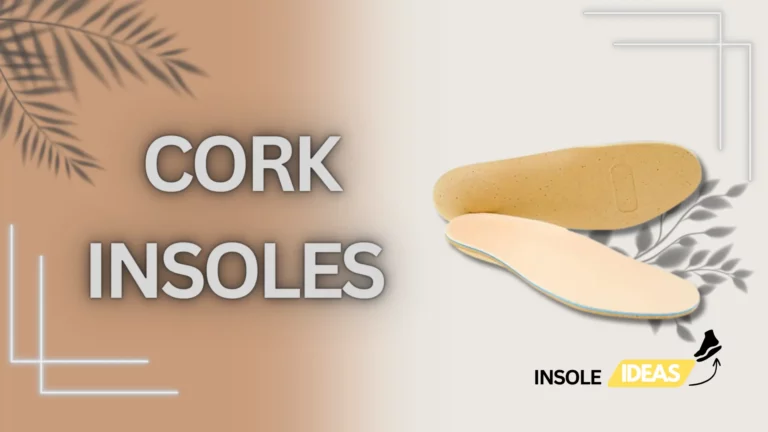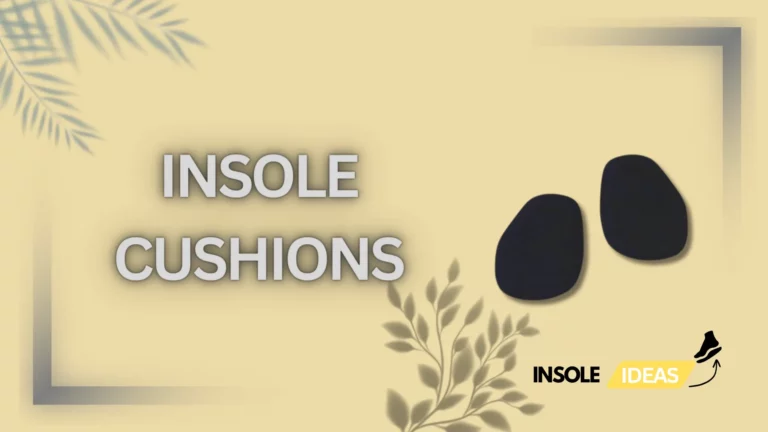Exploring the Mechanics of Insoles: How They Work?
Insoles are more than just cushioning for your feet; they play a pivotal role in supporting proper foot mechanics and overall body alignment. These inserts are designed to enhance comfort, provide stability, and alleviate various foot-related issues. By redistributing pressure and absorbing shock, insoles contribute significantly to foot health and comfort during daily activities, sports, or specialized tasks.
Importance of Insoles
They offer relief to individuals dealing with conditions like plantar fasciitis, overpronation, or high arches. Beyond remedying existing problems, insoles also serve as preventive measures against potential foot ailments. Moreover, they aid in maintaining proper posture, mitigating discomfort in the lower body, and perhaps lessening weariness from prolonged standing or strolling.
Common Foot Problems Addressed by Insoles
Insoles cater to a spectrum of foot problems encountered by people of all ages. They are particularly beneficial for those struggling with arch pain, heel spurs, metatarsalgia, or bunions. By providing customized support and cushioning, insoles alleviate discomfort associated with these conditions. They are also instrumental in preventing the worsening of such problems, offering a proactive approach to foot health.
Fundamentals of Insoles
Definition and Types of Insoles
Insoles, commonly referred to as footbeds or shoe inserts, are supplementary layers placed inside shoes to provide additional support, cushioning, and stability. There are various types of insoles available, including arch support insoles, cushioned insoles, and orthotic insoles. Each type caters to specific foot structures and conditions, offering tailored solutions for diverse needs.
Historical Perspective on Insole Development
The concept of insoles dates back centuries, evolving from simple materials like cloth or leather to more sophisticated designs and materials seen today. Initially, their purpose was primarily protective, shielding feet from rough terrain. Over time, advancements in understanding foot anatomy and biomechanics led to the development of insoles aimed at improving comfort and addressing foot-related issues.
Evolution of Insole Materials
The materials used in crafting insoles have undergone a remarkable transformation. From natural substances like cork or felt to modern innovations such as memory foam, gel inserts, and specialized fabrics, the evolution has been driven by a quest for better comfort, durability, and performance. These materials offer varying degrees of support, cushioning, and moisture-wicking properties, catering to diverse user needs and preferences.
Anatomy of the Foot
The human foot, with its 26 bones, 33 joints, and intricate web of muscles, tendons, and ligaments, is a wonder of biomechanical engineering. Understanding its structure is pivotal in comprehending its functionality and potential issues. The forefoot, midfoot, and hindfoot are the three primary divisions of the foot.
Understanding the Structure of the Foot
The foot’s structure is designed to provide stability, support, and flexibility. The arches—longitudinal and transverse—play a crucial role in distributing weight and absorbing shock during movement. The forefoot includes the toes and metatarsals, responsible for propulsion during walking, while the midfoot houses the arches, supporting the body’s weight. The hindfoot, comprising the heel and ankle, provides stability and absorbs impact.
Key Pressure Points and Stress Areas
Several pressure points exist within the foot, including the heel, ball of the foot, and the arches. These areas endure the most stress during activities like walking or standing for prolonged periods. Understanding these pressure points helps in designing supportive footwear and insoles to alleviate discomfort and prevent potential injuries.
Biomechanics of Walking
Walking is a complex process involving the coordinated movement of various parts of the body, especially the feet. The biomechanics of walking encompass the study of forces and movements involved in this fundamental activity.
Impact of Walking on the Feet
Each step while walking subjects the feet to forces multiple times our body weight. The pressure exerted on specific areas varies throughout the gait cycle, influencing the distribution of weight and stress on different parts of the feet. Understanding these impacts is crucial in addressing foot-related problems and designing effective solutions.
Role of Insoles in Optimizing Biomechanics
Insoles play a pivotal role in enhancing biomechanics by providing support, cushioning, and alignment. They help in distributing pressure evenly, reducing strain on particular areas, and improving overall foot function. Properly designed insoles can correct biomechanical issues and alleviate discomfort during movement.
Types of Insole Support
Insoles come in various types, each catering to specific foot support needs based on individual biomechanics and comfort preferences.
Arch Support Mechanisms
Arch support insoles are designed to alleviate strain on the arches, providing stability and reducing excessive pronation or supination. These insoles come in various shapes and materials to cater to different arch types and foot conditions.
Cushioning Technologies
Insoles with cushioning technologies aim to absorb shock and reduce pressure on the feet during impact. Materials like gel, foam, or air pockets are used to enhance comfort and protect the feet from excessive stress during movement.
Heel and Forefoot Support
Insoles focusing on heel and forefoot support aim to stabilize these areas, providing cushioning and alignment to reduce discomfort caused by impact and uneven weight distribution.
Orthopedic Insoles
Orthopedic insoles are specialized shoe inserts designed to address various foot conditions and improve overall foot health. These customized insoles are tailored to specific needs, catering to individuals dealing with issues like plantar fasciitis, flat feet, or high arches.
Customized Insoles for Specific Conditions
They take into account the particular requirements and structure of every person’s foot. For example, insoles that support the arch can help people with pronation problems improve their stride and reduce pain.
Collaborative Efforts with Healthcare Professionals
The creation and application of orthopedic insoles often involve collaboration between podiatrists, orthopedic specialists, and shoe designers. This collaborative effort ensures a comprehensive approach, focusing not only on immediate relief but also long-term foot health.
Thermal and Moisture Control
Foot comfort isn’t just about support; it also involves managing temperature and moisture within shoes.
Breathability and Moisture-Wicking Properties
Quality insoles incorporate materials that enhance breathability and possess moisture-wicking abilities. This helps regulate foot temperature and prevent excessive sweating, reducing the risk of issues like blisters or fungal infections.
Impact of Temperature on Foot Comfort
Extreme temperatures can significantly impact foot comfort. Insoles designed with thermal control properties help maintain a balanced environment inside shoes, ensuring comfort even in varying weather conditions.
Shock Absorption
Shock absorption is crucial in minimizing the impact of physical activities on the feet and lower limbs.
Mechanisms of Shock Absorption in Insoles
Insoles employ various mechanisms to absorb shock, such as specialized materials like gel inserts or air pockets strategically placed to cushion high-pressure areas. Understanding these mechanisms helps in creating more effective and tailored solutions.
Importance in Reducing Impact-related Injuries
Effective shock absorption in insoles plays a pivotal role in reducing the risk of injuries like stress fractures or joint pain. It disperses the forces generated during walking, running, or other activities, thereby safeguarding against excessive strain on the feet and lower body.
Gait Analysis and Insoles
Gait analysis serves as a pivotal tool in the development of tailored insoles, offering valuable insights into an individual’s walking or running patterns. By studying how a person moves, podiatrists and footwear experts can discern irregularities, pronation, or supination tendencies that impact gait. These observations become foundational in designing insoles that rectify biomechanical issues and enhance comfort.
How Gait Analysis Informs Insole Design
Gait analysis involves various methods, from visual observation to high-tech assessments like pressure mapping or 3D motion analysis. These techniques provide detailed data on foot strike, pressure distribution, and movement patterns. Analyzing this data enables experts to craft insoles that address specific pressure points, correct misalignments, and provide adequate support where needed. This precise customization can alleviate discomfort, prevent injuries, and optimize overall foot function.
Customizing Insoles Based on Individual Gait Patterns
Every individual possesses a unique gait pattern, influenced by factors such as foot structure, muscle strength, and injury history. Insole customization takes these factors into account, tailoring support and cushioning to align with an individual’s gait. Personalized insoles are designed to meet individual demands, such as decreasing excessive pronation or adapting a high arch. This helps to improve posture and lessen the pressure on muscles and joints.
Sport-Specific Insoles
Athletes demand specialized equipment to optimize their performance, and insoles designed for specific sports play a pivotal role in this pursuit. These insoles cater to the distinct biomechanical demands of different activities, enhancing comfort, stability, and ultimately, athletic prowess.
Tailoring Insoles for Various Sports
Each sport imposes unique stress on the feet and lower body. Insoles crafted for specific sports factor in these nuances. For instance, running insoles might focus on shock absorption and forward propulsion, while basketball insoles prioritize lateral stability and quick directional changes. By tailoring insoles to accommodate sport-specific movements, athletes can minimize fatigue and optimize their performance.
Enhancing Athletic Performance Through Insole Technology
Sport-specific insoles aren’t merely about comfort; they’re engineered to improve performance. Advanced materials and designs can optimize energy transfer, reduce impact forces, and even enhance proprioception, allowing athletes to feel more connected to the ground. By fine-tuning the interaction between the foot and the shoe, these insoles contribute to better balance, agility, and overall athletic output.
Insoles and Footwear Compatibility
Selecting the right insoles for different types of footwear is crucial for maximizing their benefits. Insoles need to complement the design and structure of various shoes to ensure optimal performance and comfort.
Choosing the Right Insoles for Different Shoes
Different shoes serve different purposes, from casual wear to specialized athletic gear. Insoles must align with the shoe type to provide the best support. For example, dress shoes may require thinner, more discreet insoles to maintain a sleek appearance while still offering comfort. On the other hand, sports shoes might accommodate thicker, more shock-absorbent insoles for added cushioning and support during high-impact activities.
Maximizing the Benefits of Insoles in Footwear
The synergy between insoles and footwear is pivotal for reaping the full advantages of insole technology. Properly matched insoles enhance the shoe’s inherent qualities. They can prolong the shoe’s lifespan by reducing wear and tear, prevent foot fatigue by providing extra support, and ensure a better fit, preventing movement inside the shoe that could lead to blisters or discomfort.
Longevity and Maintenance
Wearing insoles regularly can significantly impact their lifespan. Proper care and maintenance play pivotal roles in extending the longevity of insoles. One primary aspect of maintaining insoles involves regular cleaning. Depending on the material, insoles can be wiped down with a damp cloth, gently scrubbed, or even hand-washed with mild soap. Before re-inserting them into shoes, make sure they are totally dry to avoid bacterial or mold growth. Additionally, allowing insoles to air out after use helps maintain their freshness and resilience.
Proper care for extending insole lifespan
It is essential to comprehend the particular maintenance guidelines for every kind of insole. For foam-based insoles, gentle cleaning with a mild detergent and air drying is advisable. On the other hand, leather insoles may require conditioning to preserve their suppleness and prevent cracking. Regularly inspecting insoles for signs of wear, such as thinning or deterioration, allows for timely intervention, potentially prolonging their lifespan. Storing insoles properly when not in use, away from direct sunlight or excessive heat, also contributes to their longevity.
Indications for replacing insoles
Recognizing when to replace insoles is equally important. Despite proper care, insoles undergo wear and tear over time. Indications such as visible thinning, loss of shape, reduced cushioning, or an inability to provide adequate support signify the need for replacement. Moreover, if discomfort or pain while wearing shoes persists despite using insoles, it might be time to consider replacing them. Adhering to a recommended replacement schedule, typically every six to twelve months depending on usage, ensures continued foot support and comfort.
The Science Behind Insole Comfort
The comfort provided by insoles is rooted in material science and ergonomic design. Understanding the materials used in insole manufacturing sheds light on their effectiveness in providing support and comfort.
Material science in insole manufacturing
Insole materials range from foam and gel to specialized fabrics and even custom orthotics. Each material possesses distinct properties affecting cushioning, support, and moisture-wicking capabilities. Memory foam, for instance, molds to the foot’s shape, offering personalized comfort, while gel inserts distribute pressure evenly, reducing strain. Manufacturers often combine materials to optimize insole performance, utilizing breathable fabrics or antimicrobial treatments for enhanced comfort and hygiene.
Ergonomic considerations for comfort
Ergonomics plays a crucial role in insole design. Factors such as arch support, heel cupping, and metatarsal support are meticulously engineered to promote proper alignment and reduce stress on the feet. Optimizing insoles to cater to certain foot types or activities, such as prolonged standing or jogging, guarantees optimal comfort and support. Additionally, considering foot mechanics and pressure points allows for the creation of insoles that mitigate discomfort and prevent injuries, making them indispensable for overall foot health and comfort.
Conclusion
Insoles, evolving from basic foot protection to sophisticated biomechanical aids, are integral to foot health. Their diverse types and materials cater to specific needs, providing support, cushioning, and alignment. Collaborative efforts with healthcare professionals ensure tailored solutions, while their compatibility with footwear enhances comfort. Ultimately, insoles, rooted in material science and ergonomic design, revolutionize foot care by offering personalized comfort, mitigating discomfort, and optimizing foot function.



